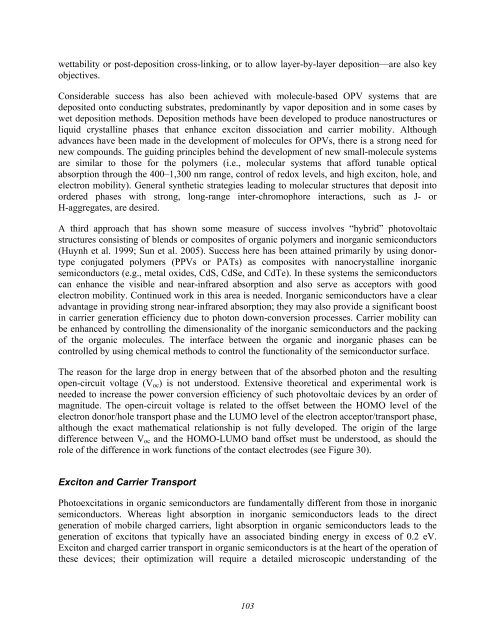Basic Research Needs for Solar Energy Utilization - Office of ...
Basic Research Needs for Solar Energy Utilization - Office of ...
Basic Research Needs for Solar Energy Utilization - Office of ...
Create successful ePaper yourself
Turn your PDF publications into a flip-book with our unique Google optimized e-Paper software.
wettability or post-deposition cross-linking, or to allow layer-by-layer deposition—are also key<br />
objectives.<br />
Considerable success has also been achieved with molecule-based OPV systems that are<br />
deposited onto conducting substrates, predominantly by vapor deposition and in some cases by<br />
wet deposition methods. Deposition methods have been developed to produce nanostructures or<br />
liquid crystalline phases that enhance exciton dissociation and carrier mobility. Although<br />
advances have been made in the development <strong>of</strong> molecules <strong>for</strong> OPVs, there is a strong need <strong>for</strong><br />
new compounds. The guiding principles behind the development <strong>of</strong> new small-molecule systems<br />
are similar to those <strong>for</strong> the polymers (i.e., molecular systems that af<strong>for</strong>d tunable optical<br />
absorption through the 400–1,300 nm range, control <strong>of</strong> redox levels, and high exciton, hole, and<br />
electron mobility). General synthetic strategies leading to molecular structures that deposit into<br />
ordered phases with strong, long-range inter-chromophore interactions, such as J- or<br />
H-aggregates, are desired.<br />
A third approach that has shown some measure <strong>of</strong> success involves “hybrid” photovoltaic<br />
structures consisting <strong>of</strong> blends or composites <strong>of</strong> organic polymers and inorganic semiconductors<br />
(Huynh et al. 1999; Sun et al. 2005). Success here has been attained primarily by using donortype<br />
conjugated polymers (PPVs or PATs) as composites with nanocrystalline inorganic<br />
semiconductors (e.g., metal oxides, CdS, CdSe, and CdTe). In these systems the semiconductors<br />
can enhance the visible and near-infrared absorption and also serve as acceptors with good<br />
electron mobility. Continued work in this area is needed. Inorganic semiconductors have a clear<br />
advantage in providing strong near-infrared absorption; they may also provide a significant boost<br />
in carrier generation efficiency due to photon down-conversion processes. Carrier mobility can<br />
be enhanced by controlling the dimensionality <strong>of</strong> the inorganic semiconductors and the packing<br />
<strong>of</strong> the organic molecules. The interface between the organic and inorganic phases can be<br />
controlled by using chemical methods to control the functionality <strong>of</strong> the semiconductor surface.<br />
The reason <strong>for</strong> the large drop in energy between that <strong>of</strong> the absorbed photon and the resulting<br />
open-circuit voltage (Voc) is not understood. Extensive theoretical and experimental work is<br />
needed to increase the power conversion efficiency <strong>of</strong> such photovoltaic devices by an order <strong>of</strong><br />
magnitude. The open-circuit voltage is related to the <strong>of</strong>fset between the HOMO level <strong>of</strong> the<br />
electron donor/hole transport phase and the LUMO level <strong>of</strong> the electron acceptor/transport phase,<br />
although the exact mathematical relationship is not fully developed. The origin <strong>of</strong> the large<br />
difference between Voc and the HOMO-LUMO band <strong>of</strong>fset must be understood, as should the<br />
role <strong>of</strong> the difference in work functions <strong>of</strong> the contact electrodes (see Figure 30).<br />
Exciton and Carrier Transport<br />
Photoexcitations in organic semiconductors are fundamentally different from those in inorganic<br />
semiconductors. Whereas light absorption in inorganic semiconductors leads to the direct<br />
generation <strong>of</strong> mobile charged carriers, light absorption in organic semiconductors leads to the<br />
generation <strong>of</strong> excitons that typically have an associated binding energy in excess <strong>of</strong> 0.2 eV.<br />
Exciton and charged carrier transport in organic semiconductors is at the heart <strong>of</strong> the operation <strong>of</strong><br />
these devices; their optimization will require a detailed microscopic understanding <strong>of</strong> the<br />
103
















